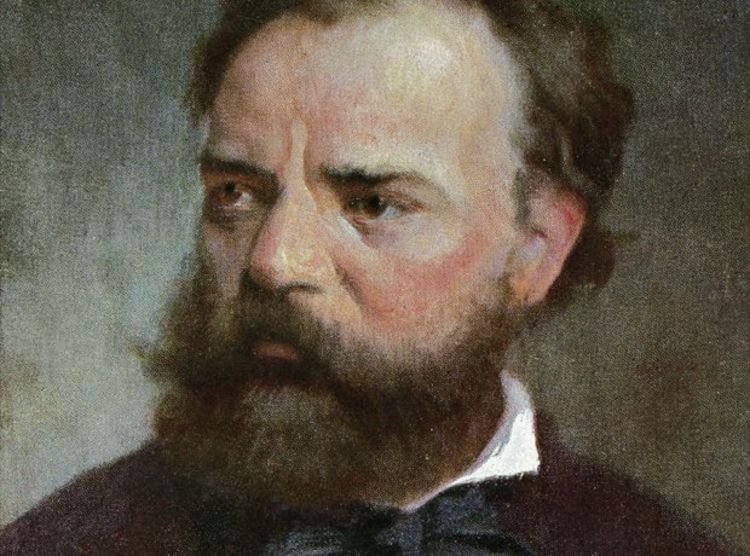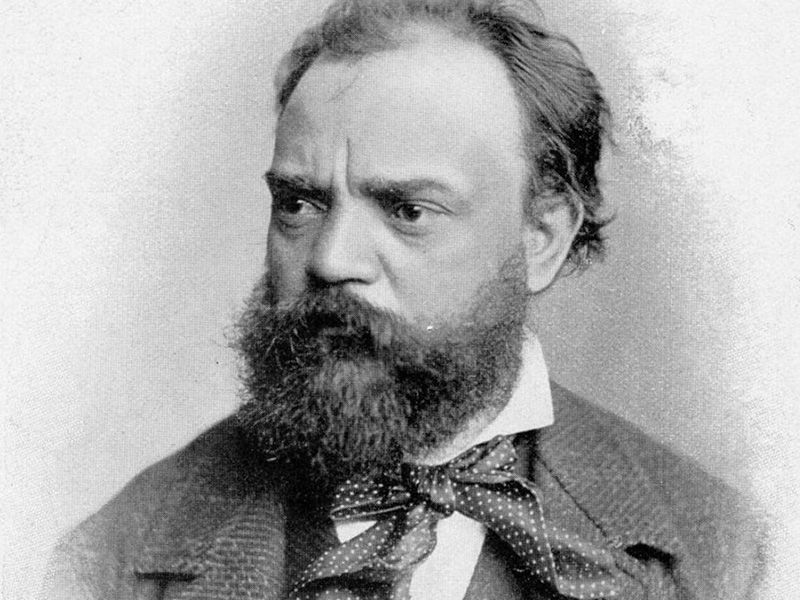Antonín Dvořák
Recognised as one of the finest 19th-century composers

Antonín Dvořák
Born 1841 (Bohemia, now Czech Republic)
Died 1904 (Prague, Czech Republic)
What was Antonín Dvořák’s early life like?
Antonín Dvořák was born in 1841 in Nelahozeves, a village on the Vltava River just north of Prague. The composer spent the first twelve years of his life there, and a good deal of time in a tavern owned by his father. The tavern had a dance hall which meant that the young Antonín was surrounded by music from an early age. It was here that he was exposed to village dance bands and Czech folk music.
The composer began to make music himself when he took up the violin. It quickly became apparent that he was musically gifted; when Dvořák was twelve years old he moved to Zlonice, where he lived with his aunt and uncle, to pursue his musical studies further. He studied at a German language school there and had the opportunity to learn other instruments alongside the violin including the piano, organ and viola.

Antonín Dvořák in 1882 © Bibliothèque nationale de France
As a teenager Dvořák was persuaded by his music teacher to enrol at the Institute for Church Music in Prague in 1857. Whilst in Prague the composer listened to and engaged with a much wider variety of music. He was fascinated by the drama of Wagner’s operas, for example, and he would later go on to compose his own operas from the mid-1860s onwards. At this time Antonín also began to compose a variety of other music including chamber works, songs, his first two symphonies and the Cello Concerto.
After graduating from the Institute, he joined the orchestra of the newly founded Provisional Czech Theater, which paid a low salary, so he was forced to supplement his income by other means. Dvořák began giving private piano lessons from 1864, and it was here that the composer met his future wife, Anna Čermáková, who was one of his pupils. The couple married in 1873, holding their wedding reception at Vysoká, a village about 50 kilometres south-west of Prague, home to Count Vaclac Kounic, Dvořák’s brother-in-law.

Antonín Dvořák in 1882 © Bibliothèque nationale de France
Antonín Dvořák in 1882 © Bibliothèque nationale de France
Dvořák Reconnects with Nature
Dvořák had always expressed an interest in the natural world, however his visit to Vysoká had a profound impact on him. Reports state that Antonín was immediately enchanted by the beauty of the chateau at Vysoká, and the composer began to take regular summer holidays there from 1873 onwards. It was at Vysoká that he took much-needed respite from his hectic life touring on the road.
In the mid 1880s the composer bought a plot of land complete with an old farmhouse from his brother-in-law. he renovated the farmhouse and converted it into his summer residence. The gardens were of particular interest to Dvořák; he was an enthusiastic, hands-on gardener, and kept pigeons too! Even whilst away the composer would regularly write letters to his groundsman, Hodik, to check on the state of his beloved garden. On one occasion, whilst teaching in New York and writing his 'New World' Symphony, Dvořák wrote to Hodik requesting an update on his plants:
'I would be delighted if you would describe to me everything you have been doing there and how it is all going. Have you moved any shrubs and, if so, where have you put them? What about those young fruit trees, wouldn’t it be better to prune any superfluous branches so that the trees are better able to grow?'
Vysoká was certainly a haven for Dvořák – the tranquility and the beauty of his patch of Bohemian land inspired many compositions. In fact, Dvořák wrote many of his works whilst staying at Vysoká including The Wild Dove, In der Natur and The Golden Spinning Wheel, which all feature in our Autumn season concerts in October 2021.

From Bohemia to America
Whilst Vysoká and its surroundings continued to capture the composer’s imagination, he was also influenced by travels elsewhere. In the early years of his marriage, in 1877, Dvořák embarked on a month of travel around Bohemia with his friend and musical contemporary Leoš Janáček. The pair are said to have visited several significant locations in the region such as Říp Mountain, Strakonice, Orlík Castle, and Husinec.
Janáček and Dvořák both celebrated the music of their Czech homeland, much like Bedřich Smetana who went before them. Indeed, around this time Dvořák continued to create works inspired by the Czech landscape and people. In 1877 he finished writing his Slavonic Dances Op 46. The String Sextet in A major Op 48, followed shortly after in 1878. Both works are overtly Czech in character and attest to the composer’s continued love for his country.
Later in his life, in 1892, Dvořák took up a teaching position at the National Conservatory of Music in New York. However, the metropolis of New York did not suit the him. He was itching to find a way to return to Europe and be with his family, when his friend and violinist Josef Kovařík suggested he went on holiday with his family to Spillville, Iowa. Dvořák spent the summer in the Czech-speaking settlement in Iowa and was apparently completely enamoured with the village. And it’s easy to understand why – the lush prairies and woods resonated with Dvořák, reminding him of home. Indeed, the American countryside sparked creativity for the composer, who created two new works within days of arriving in Spillville – his American Quartet and Quintet.
Dvořák is perhaps most famous for his Symphony No 9, ‘From the New World’. In fact, Spillville played an important creative role in the 'New World' Symphony as it was here that Dvořák refined his work. The symphony was first premiered in 1893 and weaves together the sights, sounds and emotions that Antonín experienced during his time in America. Musically the piece incorporates American and Bohemian flavours – it includes Black and Native American Spiritual songs and European Romanticism.

Orlík Castle
Orlík Castle

An Iowan Sunset (Sunset Over Dairy Farm) © Evan Ventris
An Iowan Sunset (Sunset Over Dairy Farm) © Evan Ventris
How did nature influence Dvořák’s music?
As well as informing Dvořák’s sense of identity, nature remained a key source of musical inspiration throughout the composer’s life. Thematically, nature features prominently in Dvořák’s oeuvre – to note but a few examples it inspired the pastoral Symphonies Nos 5 and 6 (1875 and 1880) and the Symphonic Poems (1896). The latter were inspired by Karel Jaromir’s Kytice ballads, which narrate Slavic folk tales with a strong emphasis on the importance of the relationship between man and nature.
'[The] expansive and idyllic Bohemian landscape, the patriarchally simple and dignified life of the Czech people, the winged rhythms, gushing melodiousness and sensuous effusive sound of Bohemian music: these were the things that formed Dvořák’s artistic soul'.
Dvořák's pigeons | Source: antonin-dvorak.cz
Dvořák's pigeons | Source: antonin-dvorak.cz

Other Works to Listen Out For
Humoresques Op 101
This set of seven short, lively piano pieces reveal a different side to the composer. The most famous is No 7 - its jaunty rhythm is said to imitate the movement of a train on tracks.
'Cypresses' String Quartet
Originally a set of 18 love songs for voice and piano, Dvořák arranged twelve of them for string quartet in 1887. These quartets are highly lyrical but melodically inventive too.
Requiem in B-flat minor
Although less well known, this funeral mass is as remarkable and moving as more famous Requiems by Mozart, Verdi and Fauré.

October 2021: Hear Dvořák Live
This October the LSO showcases the wistful Romanticism of Czech composer Antonín Dvořák.
Our concerts at the Barbican on Sunday 10 October and Sunday 31 October focus on the composer’s connection with the natural world.
Artist Portrait: Antoine Tamestit
Sunday 31 October 7pm, Barbican
Daniel Harding is joined by Antoine Tamestit as part of his LSO Artist Portrait, in a programme featuring Jörg Widmann’s Viola Concerto and two more pieces from Dvořák’s Symphonic Poems: In der Natur and The Golden Spinning Wheel.






